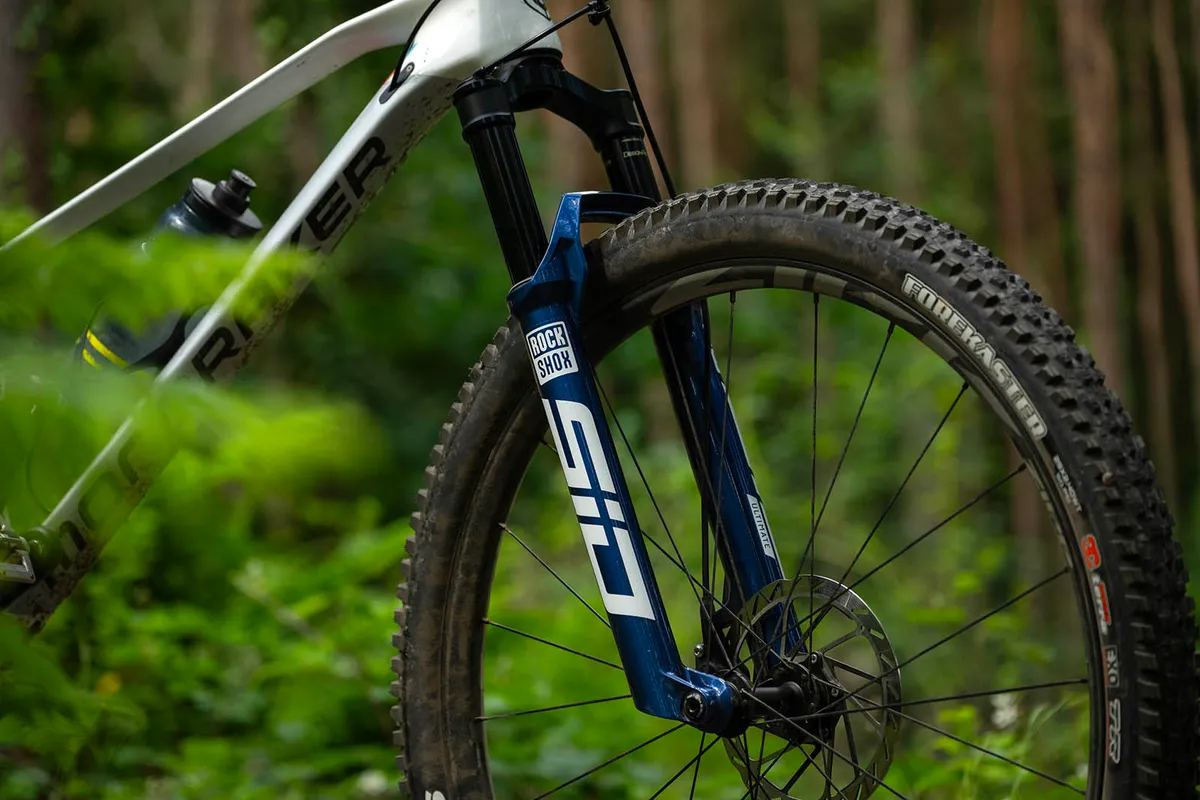Öhlins’ new RXC34 M.1 Carbon fork blends a trail-bred chassis with an all-new cross-country optimised damper. This is a lightweight, superbly controlled fork that can tame even the toughest race course. You will have to pay a high price for the privilege though.
Until recently, Öhlins has focused its mountain bike product range primarily on the gravity and trail-riding side of things.
Now though, it finally has a cross-country race fork in its stable.
Based loosely on the chassis of the RXF34 M.2 trail fork, the RXC34 M.1 Carbon sports an all-new, lightweight OTX14 damper and one-piece carbon fibre crown steerer unit (CSU).
The result is a 120mm-travel, 1,536g fork with more external adjustment than its rivals in a stiffer, if more expensive, £1,499 / $1,390 / €1,695 package.
On the trail, steering precision is a step above rivals from RockShox and Fox, while damping control and sensitivity are excellent. Hurl the RXC34 M.1 Carbon into the rough and it comes out the other side unflustered and ready for the next hit.
Small bumps are dealt with impeccably thanks to the revised air spring, while control deeper in the stroke, through to full travel, is excellent.
This doesn’t come at the expense of a race-bred feel on the climbs though, with additional damping modes that strike a great balance between traction and efficiency.
Öhlins RXC34 M.1 Carbon details and specifications

At first glance, it's hard to tell the RXC34 M.1 Carbon apart from its RXF34 M.2 sibling. This is mainly due to the fact that both forks share the same lower legs. Whereas some rival brands have a dedicated chassis for their cross-country forks, Öhlins has shared the basis of the chassis and cut the weight elsewhere.
This means you’ll find 34mm stanchions, a 160mm post-mount brake mount and a 110x15mm Boost axle. This shares the floating axle pinch-bolt design of the RXF34 M.2, enabling the fork to accommodate variations in hub widths without negatively impacting performance.
Öhlins claims this is to reduce friction and binding as the fork goes through its travel.
The CSU is a one-piece carbon fibre affair, which saves a claimed 102g over the two-piece unit found on the RXF34 M.2. The underside of the CSU is completely sealed, meaning no mud can make its way up inside the steerer tube; it's a neat weight-saving touch that will be useful during muddy cross-country races.
The damper and air spring are housed inside the opposite legs from most other forks; the damper is in the left leg and the air spring in the right.
OTX14 damper and two-chamber air spring

New for the RXC34 M.1 Carbon is the OTX14 damper. This is based on the OTX18 damper of the RXF34 M.2, but Öhlins states it's smaller and lighter, saving around 100g. The damper piston is a smaller 14mm in diameter, compared to the 18mm of the OTX18, hence the name.
As well as being lighter, Öhlins claims to have rearranged the shim stacks to better control the flow of oil between the damping circuits.
To control the damping, there are three modes: open, pedal and lockout. These provide either fully active, slightly firmer or fully locked-out damping functions.
At point of purchase, you can choose between a crown-mounted dial adjustable version (as tested) or a handlebar remote lockout.
The crown-adjust version has 12 clicks of low-speed compression in the open mode. Remote versions do without this adjustment. Regardless of the chosen control method, there are 12 clicks of low-speed rebound adjustment, located on the bottom-right fork leg.
The air spring has also received changes from the RXF34 M.2. Öhlins says it has a larger negative volume to improve sensitivity early in the travel.
This can be adjusted with up to seven negative-volume spacers, although this is not something that can be done at home or on the trail; the fork will need to be sent to an Öhlins service centre to carry this out. Out of the box, four spacers are fitted.
The positive chamber can also be adjusted with volume spacers like a traditional fork, with the possibility to fit up to five.
How much does the Öhlins RXC34 M.1 Carbon weigh?
My 120mm-travel crown-adjust test fork weighs 1,536g with an uncut steerer (265mm), brake hose guide and front axle (110x15mm Boost). This is 40g more than Öhlins' claimed weight of 1,496g.
Öhlins RXC34 M.1 Carbon performance

I tested the Öhlins RXC34 M.1 Carbon on my personal Transition Spur downcountry bike. It came equipped with a 120mm RockShox SID fork from the factory, which made it the ideal test bed.
The Öhlins RXC34 M.1 Carbon was treated to my usual cross-country and trail testing loops around North Wales, the Midlands and Shropshire, as well as a week of lift-assisted Alpine riding on the trails of the Portes Du Soleil.
Öhlins RXC34 M.1 Carbon setup

Setting up the Öhlins RXC34 M.1 Carbon was straightforward. A pressure chart on the back of the right fork leg recommended 85psi for my 80kg weight, so I inflated it to this pressure, resulting in 35mm of sag (29 per cent) in my standing riding position.
Fork sag is hard to measure accurately, because your body position varies and will differ from static to dynamic stances on the bike.
I’ve given my sag figures as a point of reference, but you should set your fork up according to your own needs.
After experimenting either side of this by 5psi in 1psi increments, I ended up back at the recommended 85psi. At this pressure, the fork delivered the small-bump feel I was looking for, and sufficient support and bottom-out resistance.
Rebound was initially set to six clicks from closed, before I settled on eight clicks from closed after a few rides.
The low-speed compression was set to fully open from the off. I experimented with adding more clicks, one at a time, but preferred the feel when the low-speed was fully open.
The progression in the positive air spring felt great from the off and I felt no need to deviate from the standard setup of two as they come supplied stock from the factory.
Öhlins RXC34 M.1 Carbon ride impressions

The Öhlins RXC34 M.1 Carbon impressed from the first ride.
It felt pleasingly supple from the off, requiring no break-in period. Small bumps, rocks and roots are dealt with well, and even deeper in the stroke over repeated hits, it retains a smooth and supple – if not exactly plush – feel.
There's a firmness to the fork befitting of its cross-country racing remit – this isn’t a trail fork after all. Even so, the ability to absorb chatter and mute feedback through the handlebar is impressive.
Over bigger trail features and imperfections, there's plenty of progression in the air spring so that bottom-outs are rarely felt – even if the O-ring indicated I had indeed used all of the travel on a few occasions.
The fork rides high in its stroke, preserving the bike's geometry well.
The damping control is also impressive. While the rebound is quite noisy, the transition from rebound to compression is smooth, with no top-out or spiking and a seamless feel. Over repeated hits, it never feels as though the damper is being overwhelmed.
There were no spiking or choking moments, even when really pushing the fork through the often brutal rocks of my local trails or on prolonged Alpine terrain.
The firmer pedal mode is ideal for long fire-road climbing stints, offering a stiffer, less active pedalling platform for an efficient feel, while still maintaining enough give to absorb bigger hits.
I found I used this mode sparingly; while the fork is supple, it doesn’t dive excessively into its travel or bob when hard on the pedals, in or out of the saddle. I preferred this setting to maximise the tracking of the fork on rougher climbs.
The lock mode is a very firm lockout and, as such, I rarely used it. I can appreciate the rock-solid feel would be desirable in a racing situation, though.
Moving over to the chassis and steering precision is outstanding. Aim for a line and the fork will hold it impeccably, as you'd perhaps expect given it shares its lower legs with the brawnier RXF34 M.2.
It isn’t a fork that makes you feel you need to back off when the terrain gets gnarly. The stiffness encourages you to let the bike run with it, and the control offered by the damper and air spring further add to its unflappable feel, in relative terms. It only has 120mm of (excellently controlled) travel after all.
It certainly feels more like a trail fork than a beefed-up cross-country model.
Racers may see the floating axle as a negative. With a pinch bolt to undo as well as the axle itself, wheel removal isn’t the fastest. In the heat of a racing situation, this will mean a few more lost seconds if you need to change out a wheel after suffering a flat tyre.
For everyday use, it's an annoyance if you have to remove the front wheel to fit the bike into your car, for example.
I think the axle and oddly placed rebound sticker are the only downsides from a usability standpoint, leaving only the higher price compared to rival mountain bike forks as a potential stumbling block for prospective riders.
How does the Öhlins RXC34 M.1 Carbon compare to the 2024 RockShox SID Ultimate 3P?

Compared to the category-leading SID, the Öhlins is marginally lighter (1,536g vs 1,600g), although it's considerably more expensive, at £1,499 / €1,695 / $1,390, against the SID’s £1,069 / €1,199 / $999.
That alone will be enough to sway some riders, but in pure performance terms, the two are a lot closer matched.
The RXC34 M.1 Carbon has a stiffer chassis and more precise steering, as well as featuring more adjustment, with more finely tunable low-speed compression and volume-spacer adjustments in both the positive and negative air springs.
On the trail, the Öhlins feels a little heavier-handed in its damping. While I tried faster rebound speeds, all the way up to having the rebound damping wide open, it never felt as lively as the SID, which is notably active.
You’re fully aware of how much travel you’re using and how the fork is behaving, with more feedback, but not in a jarring or uncomfortable way.
The best way I can describe the Öhlins is calm – it goes about its business with little fuss, aside from a bit of noise from the rebound circuit.
Plough headfirst into chundery sections of trail and it holds a line, tackling gnarly terrain confidently. Its reactions almost fade away into the background.
Both forks are brilliantly controlled and perform their duties of providing traction and comfort exceptionally well.
Overall, I preferred the Öhlins fork's calmer demeanour and more precise steering control. It felt ideally suited to my Transition Spur, which is on the more progressive side of the downcountry bikes spectrum.
However, there's no denying the Öhlins is a much pricer proposition.
Öhlins RXC34 M.1 Carbon bottom line

Öhlins’ first cross-country mountain bike fork is an impressive performer, taking the fight to the best XC forks you can buy right from the off.
It is lightweight, has an exceptionally stiff chassis and performs its duties in a smooth, controlled and trail-calming manner.
You’ll pay a hefty price and have to live with one or two usability niggles, but the result is an incredibly capable fork that stands as one of the best short-travel suspension forks you can buy.
Product
| Brand | Ohlins |
| Price | €1695.00, £1499.00, $1390.00 |
| Weight | 1536g |
Features
| Wheel size | 29in_700c |
| Offset | 44.0000 |
| Offset | MILLIMETER |
| Travel | 120.0000 |
| Travel | MILLIMETER |
